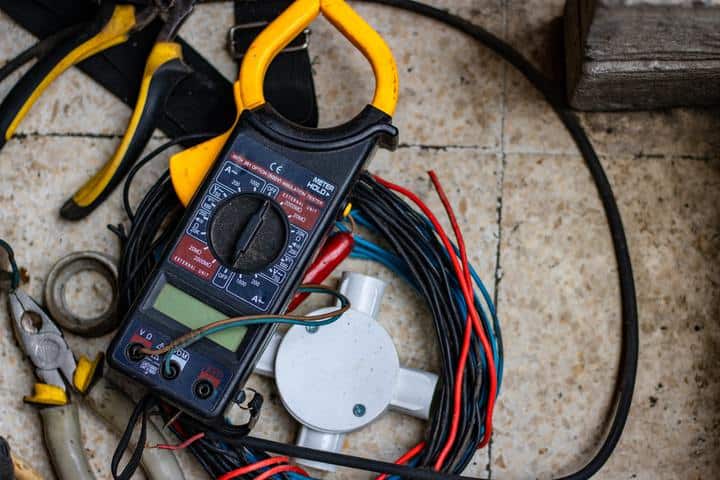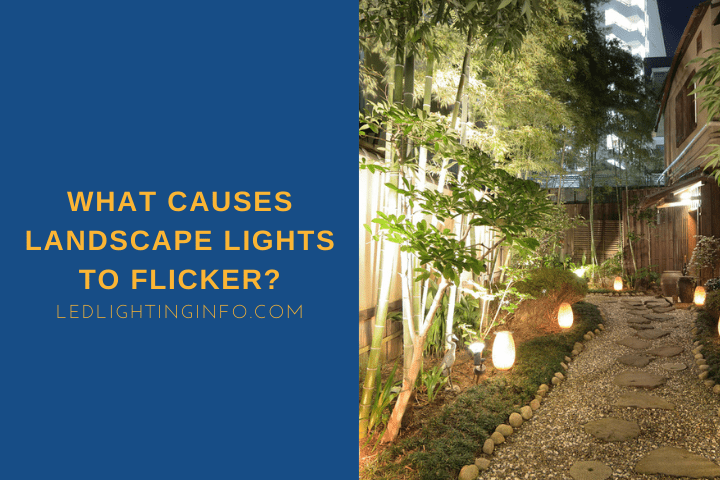Landscape lighting is beautiful when it works.
Your garden and outdoor spaces will be gently lit, giving your home a more premium feel and increasing the security of your property too.
Unfortunately, there may be times when it doesn’t quite work properly, either with lights that aren’t switched on or flickering lights.
Flickering landscape lighting is super annoying, so you’ll want to tackle it immediately.
Flickering landscape lights could be caused by a bad transformer or one that’s overloaded. There might be dirt in the connections that interrupt the current, or the circuit may be suffering from a voltage drop. Once the issue is identified, it can usually be fixed easily.
But you can only fix it once you’ve found the cause. So let’s take a look at:
- The most common causes of flickering landscape lights
- How a bad transformer could also be the cause
- How to fix your flickering lights
What Causes Low Voltage Landscape Lights To Flicker?

When it comes to finding the cause of your flickering lights, it’s best to start with the most common causes without having to start digging up the cables.
Overloaded Power Supply
Usually, if your landscape lights are flickering, you’ve overloaded the power supply.
Every landscape lighting setup needs a transformer, which steps the current down from your home to the required levels for outdoor lighting, usually 12V.
However, in doing so, they also have a limit on the maximum Wattage you can wire into them.
This varies depending on the quality of the transformer, with cheaper options tending to allow up to 150 Watts or 200 Watts.
While more expensive ones could range all the way up to 1200W.
However, that’s the absolute maximum they can hold. So it’s actually recommended you only add up to 80% of the total Wattage to a circuit.
Therefore, any fluctuations in the current or variances in exactly how much is drawn wouldn’t have an impact.
If you didn’t do the math when you installed your landscape lighting, check your transformer, and check each light.
You should be able to find the total Wattage you should be connecting and the actual total of your lights.
If the lights’ total Wattage exceeds 80% of the transformer’s rating, you’ve likely found the problem.
Dirty Connections In The Circuit
Once you’ve ruled out the ‘easy’ option and checked the transformer, your next step is to look at the connections.
If any dirt has got into the circuit, it could be causing problems with the current.
It shouldn’t be an issue for the main wires, providing they haven’t partially severed. Instead, check where the wire has been split to connect a light.
In these connections, you’re more likely to find a weakness.
When the landscape lighting was installed with cheap connectors or push-pin connectors were used, and the setup is old, there may be gaps that have developed.
If the wires are buried or lying on the ground, then there’s high chance dirt could have gotten into them.
Don’t worry, it’s a relatively simple fix, which I’ll cover in more detail below.
Voltage Drop

When installing landscape lighting, you must use the right wire gauge.
Wires, just like any electrical component, provide resistance in a circuit.
Use wires that are too thin, and that resistance will cause the voltage to drop too far, meaning the lights don’t get the power they need.
Finding out which gauge of wire has been used is tricky if you didn’t install the landscape lights yourself.
Since they often aren’t marked, and the measurements are so minute, you may struggle to accurately measure them yourself.
However, if you installed the lights, check which wire you used.
You may still have the spool or the email receipt if you ordered it online.
Once you know the wire, you can use the constant for that wire to work out whether the voltage drop is acceptable.
Most landscape lighting wire is made from copper, so this is the constant information for copper wire (if you’re using a different material wire you can Google to find the wire constant):
| Wire Gauge | Constant |
|---|---|
| 18/2 | 1380 |
| 16/2 | 2200 |
| 14/2 | 3500 |
| 12/2 | 7500 |
| 10/2 | 11920 |
| 8/2 | 18960 |
Multiply the total Wattage of the lights by the distance in feet.
Divide this by the relevant wire constant and multiply your answer by 2.
If the answer is more than 1.5, the voltage is dropping too far, and your lights aren’t getting the power they need.
Can A Bad Transformer Cause Flickering?

There’s also a chance that your transformer might not be overloaded, but it just isn’t up to the job of powering your landscape lights.
It might be a wear-and-tear issue if installed for a long time.
If you’ve bought a cheap transformer, it may not be up to scratch.
Start with a visual inspection.
Does it look rusted inside, or are there any bulging or signs that it may have overheated?
If you can’t see anything wrong, you could use a voltage meter to check both the input to the transformer and the output.
When the voltage is less than 80% of what it should be then, the transformer may just need replacing.
How To Fix Flickering Landscape Lighting?

How you fix flickering lights will depend on the cause of the problem.
For all of these, it should be obvious, but always switch off the power before you do any kind of repairs.
Overloaded Power Supply
If the power supply is overloaded, then you’ve got two options. You either need to increase the power or decrease the load.
Removing a couple of lights is easier, but it’s a less elegant solution.
What happens if you decide you want to upgrade again in the future?
The best thing to do is replace your transformer with one rated for a higher Wattage.
This means you get to keep all of your lights as they are, but it can open up the opportunity to expand your lighting setup in the future.
Dirty Connections
If you’ve identified a dirty wire connection, then you’ll want to re-do the connection.
Remove the old connector and clean the exposed wires to remove any dirt.
Trim them back when you can to make sure no moisture or soil remains.
Then, replace the connector – it’s best to use a silicone-filled wire nut since they create the best seal and aren’t as liable to wear down over time and allow dirt or moisture in.
With the connection re-installed and everything properly sealed up again, you shouldn’t have flickering lights.
Voltage Drop
If you’ve established that your landscape lighting wire isn’t the right gauge, you’ve two possible ways to fix it.
Neither is super-easy, but one is better than the other.
The more intensive option is to completely dig up the wire and replace it. A huge amount of work, but one that would solve the problem.
The alternative is to re-wire the circuit to change it from series to parallel.
Voltage drop is only an issue on one loop of a circuit, so if you can change the setup to a parallel one and have fewer lights on each loop, the drop won’t be an issue.
It’s still a lot of work to change a circuit from series to parallel but it’s better than digging up the entire garden and starting again.
Bad Transformer

Once a transformer has failed, the best thing you can do is replace it.
Water or heat damage will render it unsafe, so trying to repair it isn’t the smart choice.
It’s quite a straightforward job since you just need to disconnect the input and output wires and then remove the transformer, which is often held in place with just a couple of screws.
Once the new one is in and everything is reconnected, you’ll have peace of mind that you’ve got a shiny transformer that should last you a good few years.
Also read: How To Set Landscape Lighting Timer?
Final Words
Flickering landscape lights can be a real headache. Still, if you follow this article, you can tick off the likely causes and find the needed solution.
Often, it’s just a case of swapping out the transformer, but sometimes there is a little more to it.
The results will be worth it once those pesky lights stop flashing on and off.
Were there any potential causes of flickering landscape lights you can think of that I missed?
Let me know the easiest way to fix it.

